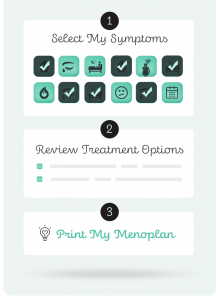Symptoms
WHAT IS IT?
Your period may change dramatically during the menopause transition. There may be changes in length between cycles, amount of flow, and how many days you bleed each time.
Shorter cycles (21-27 days) are common early in the transition. Longer cycles and skipped periods (> 28 days) are more common as women approach their last menstrual period.
Bleeding tends to be heavier, and may require many more pad/tampon changes. Wearing 2 tampons (don’t forget you placed 2!) with a panty liner for insurance on gusher days helps. You may bleed for more days in a row, too. It can be very annoying. But, conversely, flows can be lighter for some women.
Not every woman notices changes in the amount of flow. For some, their period may skip a few months every now and then, until one day they realize it’s stopped.
WHAT’S HAPPENING TO MY BODY?
Before the menopause transition, hormone levels rise and fall in a regular pattern. This prepares the uterus for pregnancy. If pregnancy doesn’t happen the lining is released as a period. During the menopause transition, hormone patterns become irregular. There are more or fewer days between periods, skipped periods, and the amount of blood may be lighter or heavier than normal.
These changes in cycle length are normal. If the intervals are not less than 21 days, and the bleeding pattern is not bothersome, irregular bleeding does not need treatment.
Women with periods less than 21 days apart (the time from the start of one period to the next) are at risk for endometrial precancer. They should see their health care provider. An endometrial biopsy will likely be done.
Heavy bleeding doesn’t mean there is a a problem. It can be bothersome. There may be a feeling of pressure or heaviness in the lower abdomen, particularly in women with uterine fibroids.
On the other hand, heavy bleeding can cause anemia, need for transfusion and in rare circumstances, hysterectomy. It can be a sign of endometrial precancer or cancer.
Contact your healthcare provider if you have any of the bleeding changes described below:
- Very heavy bleeding (soaking through a sanitary product every hour for more than 2 hours in a row).
- Bleeding after sex or between periods.
- Bleeding at intervals less than 21 days from the first day of bleeding of one episode to the first day of bleeding to the next episode.
- Several periods that last three days longer than usual or prolonged bleeding, more than 7 days.
- Bleeding or spotting after having no period or spotting for a year or longer.
WHAT TO EXPECT
Women, on average, begin to see differences in menstrual cycle lengths of 7 or more days about 6 to 8 years before the final menstrual period. About 2 years before the final menstrual period women begin to have 60 or more days without bleeding between periods. These are averages, and women differ a lot. About 15% to 25% of women have almost no change in menstrual cycle length before their final period.
Treatments that are inappropriate or have not been studied for this symptom are not listed.
Goldstein SR, Lumsden MA. Abnormal uterine bleeding in perimenopause. 2017 Oct;20(5):414-420. doi:10.1080/13697137.2017.1358921. PMID: 28780893.
Harlow SD, Paramsothy P. Menstruation and the menopausal transition. Obstet Gynecol Clin North Am. 2011;38(3):595‐ doi:10.1016/j.ogc.2011.05.010. PMID: 21961722.
Harvard Health Publishing. “Abnormal Uterine Bleeding in Peri- and Postmenopausal Women.” Harvard Health, Jan. 2011, health.harvard.edu/womens-health/abnormal-uterine-bleeding-in-peri-and-postmenopausal-women.
“Perimenopausal Bleeding and Bleeding After Menopause.” ACOG, American College of Obstetricians and Gynecologists, Nov. 2018, acog.org/Patients/FAQs/Perimenopausal-Bleeding-and-Bleeding-After-Menopause?IsMobileSet=false.
Treloar AE, Boynton RE, Behn BG, Brown BW. Variation of the human menstrual cycle through reproductive life. Int J Fertil. 1967;12(1 Pt 2):77–126. PMID: 55419031.
Wallace RB, Sherman BM, Bean JA, Treloar AE, Schlabaugh L. Probability of menopause with increasing duration of amenorrhea in middle-aged women. Am J Obstet Gynecol. 1979;135(8):1021–1024. doi:10.1016/0002-9378(79)90729-4. PMID: 517585.
Last reviewed: April, 2021.



